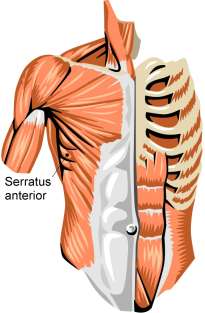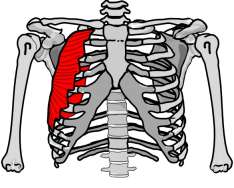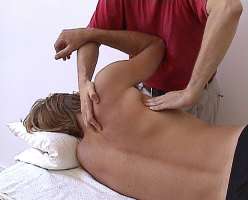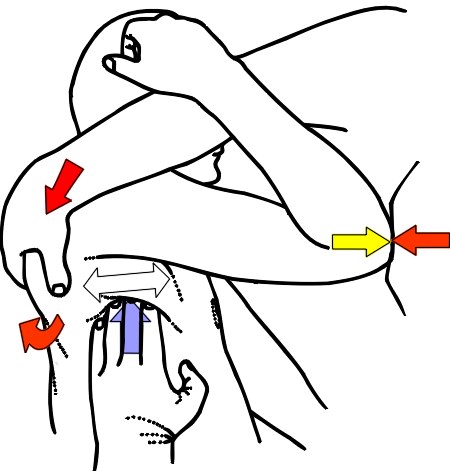
20. Serratus anterior
Anatomy
The muscle arises from interdigitations on ribs 1 to 8 (sometimes 10). It runs back and around the thoracic as a muscular sheet, passing under the scapula to attach along the medial border of scapula. The lower four or five digitations are more powerful. They attach on the inferior angle of the scapula and act in upward rotation.
 |
 |
Action: Protraction and upward rotation of scapula. Reaching or pushing and taking the arm above the head.
Nerve supply: Long thoracic nerve (C5, 6 and 7). Damage leads to weakness of serratus anterior and winging of scapula.
Technique 1 Kneading serratus anterior.
Patient
- Sidelying with the front of the body near to the side of the table that you are standing.
- The head is resting on a pillow or folded towel.
- The shoulder the patient is lying on is positioned so that the trunk remains perpendicular to the table. The arm will lie under the patient or in front of the patient. Pillow may be used to prop up the patient.
- The uppermost arm is flexed to 90 degrees.
- The forearm is flexed so the patient's hand rests on the side of their head.
 Picture 20.1
Picture 20.1Therapist
- Stand by the side of the table facing the patient and level with their shoulders.
- Reach under the patient's uppermost forearm with your cephalad hand and grasp the patient's scapula.
- Your fingertips contact the rib angles.
- Place the patient's elbow on your sternum.
- Place the palm of your caudad hand flat on the patient's lateral rib cage.
- The fingertips of your hand are at right angles to the fibres of serratus anterior.
Applicator
- All fingertips of one hands.
Contact
- Start at the lower border of serratus anterior and work up into the axilla.
- Alternatively start on the upper fibres of serratus anterior and work down and across the ribs and muscle fibres using a rake like action with the fingers.
- The scapula and pectoralis muscles restrict access to parts of serratus.
- Follow the lateral border of the scapula.
- Work the tendon at the inferior angle of the scapula.
- Work down to rib eight and as far anteriorly as the mid clavicular line.
- As you move down the rib cage more of serratus anterior will become accessible.
Tissue tension
- Take up the transverse tissue tension by pushing up superiorly or raking across the muscle fibres inferiorly with your fingertips. The upper fibres are roughly parallel but the lower fibres of the muscle diverge.
- Take up the longitudinal tension by pushing against the patient's elbow. The force is transmitted through the arm to the scapula.
- With your cephalad hand guide the scapula medially into retraction.
- Take up the longitudinal tension on the lower fibres of serratus anterior by guiding the scapular into retraction and downward rotation.
 Figure 20.1
Figure 20.1| Muscle Fibres | Primary Force | Secondary Force | Stretch Force | Contraction Force |
Kneading
- Apply a rhythmical cycle of transverse and longitudinal force.
- When the muscle is at an optimal longitudinal tension increase the transverse pressure.
- Your pressure should be just short of discomfort.
- To relax the muscle, work with the patients breathing cycle, about 15 breaths per minute.
- To stimulate increase your speed to about 40 cycles per minute.
Active component
- Ask the patient to take a deep breath and hold it in.
- Ask the patient to attempt to push their elbow away and into your chest for 3 to 5 seconds using a 10% effort. The serratus anterior will contract.
- Resist their effort and maintain tissue lockup including scapula stabilisation throughout the technique.
- Ask the patient to exhale and to relax their muscle contraction.
- As soon as you feel that the patient has relaxed their muscle completely (about 1-3 seconds) take up the tissue slack by increasing the primary and longitudinal tension.
- Take up the slack after each contraction and during exhalation.
- Repeat 2 or 3 times or as required.